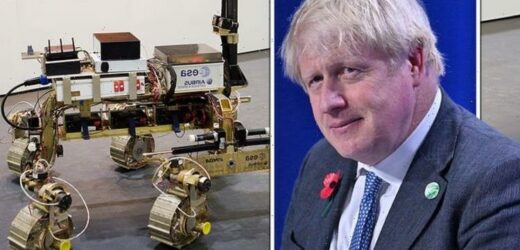ExoMars: Engineer reveals mission could expose life on Mars
We use your sign-up to provide content in ways you’ve consented to and to improve our understanding of you. This may include adverts from us and 3rd parties based on our understanding. You can unsubscribe at any time. More info
The company’s Director of UK Communications Jeremy Close was speaking prior to the Advanced Engineering UK conference, billed as the country’s largest annual gathering of engineers, being staged at NEC Birmingham on Wednesday and Thursday. ExoMars, which stands for Exobiology on Mars, is a joint endeavour between the European Space Agency and the Russian space agency, Roscosmos with the primary goal being to address the question of whether life has ever existed on the Red Planet.
Airbus Space and Defence, based in Stevenage in Hertfordshire, has been involved from its inception, building the prototype vehicle known as Bruno, which was assembled in the company’s bio-burden super cleanroom nicknamed Mars Yard.
With respect to Mr Sunak’s ambitions for UK science, voiced during his budget speech last month, Mr Close said: “Bruno is just one example of the outstanding UK technologies being exhibited at Advanced Engineering this year.
“Exhibitions like this play a vital role as they allow businesses from different sectors to come together, exchange ideas and do business.”


He added: “Over the last ten years, investment in UK space has grown both from private funds and from government.
“It’s clear to see from projects like the ExoMars rover, that the UK has all of the skills required to become a leader in high-tech projects like this.”
The ExoMars mission bringing the final version of the Rover, named Rosalind Franklin, was originally supposed to launch in 2020.
JUST IN: Macron sidekick Beaune ‘making Anglo-French relations worse’

Mr Close said: “Because of the orbits of the Earth and Mars, there are only launch opportunities every 26 months, else it takes too much time and fuel to make the journey. So, the rover will now launch in 2022.
“Bruno was extremely important to the process of designing and testing the ExoMars rover, particularly in the development of the autonomous navigation system and the overall locomotion system.”
Explaining the Rover’s intricate design, which will enable it to navigate the Martian surface, he said: “It can take up to 45 minutes for a signal to go back and forth to Mars, so driving a rover by remote control can be very difficult.
DON’T MISS
Breakthrough study of ‘waterworlds’ could uncover alien life [REPORT]
ET hunter claims evidence of alien UFOs is being kept from the public [PICTURES]
‘Worms’ and ‘shrimps’ spotted on Mars in scientist’s bizarre study [INTERVIEW]


“To overcome this, the ExoMars rover has autonomous navigation capability, so that it can send a picture back, then the controllers on Earth will tell it where to go and it will find its own way.
“This involves clever software that doesn’t need much power, as the only electricity comes from the solar arrays or batteries.
“The power generated needs to be saved to operate the internal instruments to search for life.”

Express.co.uk paid a visit to Mars Yard in 2018, being offered an exclusive behind-the-scenes tour by ExoMars Delivery Manager Abbie Hutty.
She said of the facility’s simulated Martian terrain: “I always find it bizarrely Earth-like – like somewhere in Spain or Arizona.
“The sand colour is very similar to the Martian surface as is the temperature of the light in here.”

As for the notoriously difficult job of landing a probe on Mars, she added: “I can see it all coming together but something could go wrong at launch or landing and then that’s that.
“Those are the types of things you can’t control so you have to concentrate on the things which you can.
“There are no 100 percent guarantees when it comes to space.”
Source: Read Full Article


